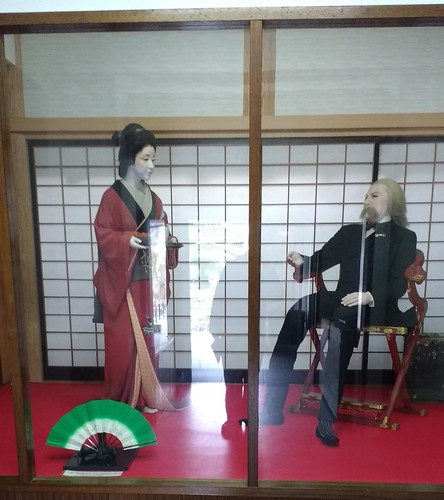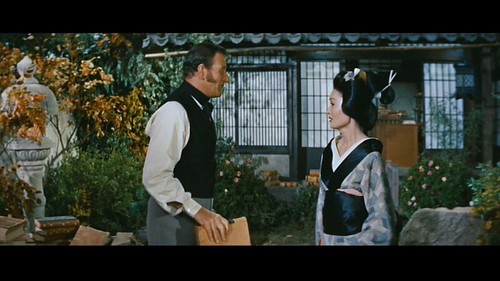At the end of my previous entry, I was checking out of the Shimoda Tokyu Hotel on the morning of Wednesday, March 23, when I found a brochure describing other sites in Shimoda that I was now determined to visit. So, after checking out, I headed back into town to seek out Gokusenji Temple, where Townsend Harris had set up the first American consulate in Japan in 1856, from which he labored to effect a treaty with the Shogun, and Hofukuji Temple, which housed the Okichi Memorial Museum and gravesite, devoted to Okichi, the Shimoda woman who had lived with and worked with Harris during his stay. The closest site was Hofukuji Temple, which wasn’t easy to reach, given the vagueness of the map I’d gotten from the tourist center, but I did find the Shimoda History Museum and went in to ask directions. I had hoped to see this museum also, but was eager to get to the other sites and I was somewhat put off by the 1200 yen admission fee, almost three times as much as the norm for the other places. I probably missed some interesting things, judging from their awkwardly-worded brochure.
But I did find Hofukuji Temple and the Okichi Museum.
Okichi’s story is explained in a biographical brochure they provided.
According to the brochure, she was a former geisha engaged to a ship-carpenter named Tsurumatsu when Harris spotted her and took an interest in her. A Shogunate official, seeking an advantage in the treaty negotiations with Harris, offered Okichi to the American and used a complicated combination of bribery and “cunning” entreaty to break her engagement with Tsurumatsu and persuade her to go with Harris. In 1858, Harris was promoted to “minister plenipotentiary” and moved the legation to Edo (Tokyo) with Okichi in tow. The implication is that she was something of a mistress to Harris, who apparently had specifically asked for her. While this “romance” was lauded in the 1958 Hollywood movie about Harris’ stint in Japan, THE BARBARIAN AND THE GEISHA, starring John Wayne as Harris and Eiko Ando as Okichi and directed by John Huston, it’s treated somewhat more tragically in the museum devoted to Okichi. And, I would learn later, the whole account is generally dismissed by historians as fiction. (I’ll add a quote to the end of this piece.) Photography was allowed, so I can share samples of what was in the museum. I found few captions in English, so I didn’t often know the significance of the various artifacts or pictures on display, nor did I always know who was being depicted alongside Okichi. Nor am I sure these were all done by Japanese artists.
But you can see the American “Black Ships” in the backgrounds of some paintings and westerners in others.
The few captions in English I found:
And her gravesite behind the temple:
I was a bit disappointed that there was no mention of THE BARBARIAN AND THE GEISHA in the museum exhibits, although other fictional portrayals were acknowledged.
And there was, apparently, a new production being advertised on a billboard nearby:
The DVD was, however, available for sale in the museum store.
I then had to travel clear across town to the Gyokusenji Temple where Harris had lived and set up his consulate office. I wound up taking a local bus part of the way and walking the rest. The temple was set back from the street quite a ways and surrounded by other, newer buildings, meaning there hadn’t been much of an effort to preserve space around the temple and its newer, adjacent museum.
Gyokusenji Temple:
There was an adjacent museum, of a design wildly at odds with the architecture of the temple.
Pictures were allowed in parts of the museum, so I did get some documentation. The temple includes the rooms where Harris and his Dutch interpreter, Henry Heusken, lived.
The museum includes full-size mannequins depicting Harris and Okichi.
The displays cover a lot of Harris’s career, including his founding of the Free Academy in New York in 1847, which later became the City College of New York and the foundation for the City University of New York. (In the fall of 2009, I taught a course on anime at City College.)
Other items on display:
And a portrait of Commodore Perry, who was covered in my previous blog entry:
And a quote from Harris’s journal:
There are also letters and photos of visits by prominent Americans in more recent times.
Former Ambassador and Japan expert Edwin O. Reischauer:
And a document signed by President Franklin Pierce:
There was also a cemetery on the premises where five American sailors who had died on the Black Ships (from illness or accident) were interred. After the museum, I went out to visit the graves of the sailors and pay my respects to them.
I then headed back to town and the train back to Tokyo. On the way, I passed a tourist cruise ship designed to resemble a Black Ship and even named after one of them.
In a food and gift shop at the train station, I found lots of snack products designed as tie-ins to the kurofune (Black Ships):
And other Black Ship merchandise as well:
Plus some Izu Dancer tie-in products:
For some reason, I wasn’t compelled to buy any of them.
I was tired and my feet were hurting and I was not up for a trip to Kawazu Seven Falls, where the Izu Dancer and her smitten student were supposed to have walked, which would have required a train ride, transfer to a bus and then a long walk, so I scratched it off the itinerary.
On the way back, shooting from the speeding train, I did manage to take some shots of piers on the seacoast that looked closer to the piers depicted in films of “The Izu Dancer” than they did to the actual pier.
And in Shibuya, Tokyo, a few days later, I saw another reference to Commodore Perry:
I have a lot more to say about the whole issue of “opening up” Japan, based on insights I acquired from watching Japanese society up close for four weeks, but I’ll save those for a future entry. In the meantime, I’ll just say that whatever goals Perry, Harris and American policy makers had at the time, the ultimate result for people like me is the abundance of Japanese movies, anime, manga and J-pop for us to enjoy today, from Akira Kurosawa and Yasujiro Ozu to Hayao Miyazaki and Osamu Tezuka to Hibari Misora and Morning Musume, something that might not have happened in quite the same way had Americans not made those crucial moves 160 years ago. That may seem a bit selfish on my part, but I don’t think the Japanese, in the long run, have fared too badly as a result.
Since returning home, I’ve watched my Blu-ray disc of THE BARBARIAN AND THE GEISHA and am impressed with its recreation of 1856 Japan and the meetings of Harris and assorted Japanese officials, including the ruling Shogun. We get a sense from these scenes of the extraordinary collision of cultures and just how big a shock it was to both sides. The film was shot on location in Japan, although I’m not sure exactly where the Shimoda scenes were shot. The areas seen in long shot certainly look like the area I was in. Sometimes, there’s a little location cheating, as when Baron Tamura (So Yamamura) brings the Harris party to Edo for the first time. The scene where the procession enters Edo was shot at the gate of Todaiji Temple in Nara, a site I visited, which is hundreds of miles from Edo (Tokyo).
I’ll have more to say about THE BARBARIAN AND THE GEISHA in a future blog entry, but it remains one of the better films about historical Japanese-American relations and is certainly a far sight better than the 1981 U.S.-Japan co-production, THE BUSHIDO BLADE, which inserted Commodore Perry, played by Richard Boone, and a number of key Japanese figures from that era (including one played by Toshiro Mifune) into a totally-manufactured action movie plot with way more English-speaking Japanese than were likely in 1854.
Finally, here is a quote from the website of the Consulate General of Japan in New York about Harris and his relationship with Okichi:
The Story of Okichi-san Harris was serious and intelligent, yet always amiable. It is said that a few wild indiscretions in his youth may have led him to later become a strict teetotaler. But unlike some Westerners arriving in Japan at the time, Harris was never overly moralistic in his judgment of Japanese culture. It is interesting, then, that a legend has grown up around Harris concerning a relationship with a Japanese geisha named Okichi-san. According to the popular story, Harris was involved in a love affair with a beautiful geisha who, in a “Madame Butterfly” like tragedy, eventually killed herself. Actually, most historians now agree that this story is not true. There was, in fact, a woman named Okichi who lived in Shimoda and who may have worked at Harris’s residence. But it seems that the legend of a love affair was just that. Still, the story has taken on a life of its own and has become very popular on both sides of the Pacific. In 1958 a movie made by legendary director John Huston had none other than John Wayne playing Harris to Eiko Ando’s Okichi in the big-screen Hollywood movie called The Barbarian and the Geisha.
For the complete entry on Harris, please follow this link:
http://www.ny.us.emb-japan.go.jp/150th/html/nyepiE2a.htm































































































thank you for a fascinating write-up!
Yeah, this was really interesting—I liked the drawn pictures of the geishas sitting around–they were pretty. Good historical stuff,too
Forgot to mention that the cookies and pies seemed like a weird thing to tie into this particular historical event (the opening of Japan to the Western world) but human beings have always found a way to cash in on and sell anything,lol.
I’m a Japanese. In fact, because I was thinking whether visit to Shimoda, these articles was very helpful. Did you not visited to Renjo Photo Memorial-Hall?